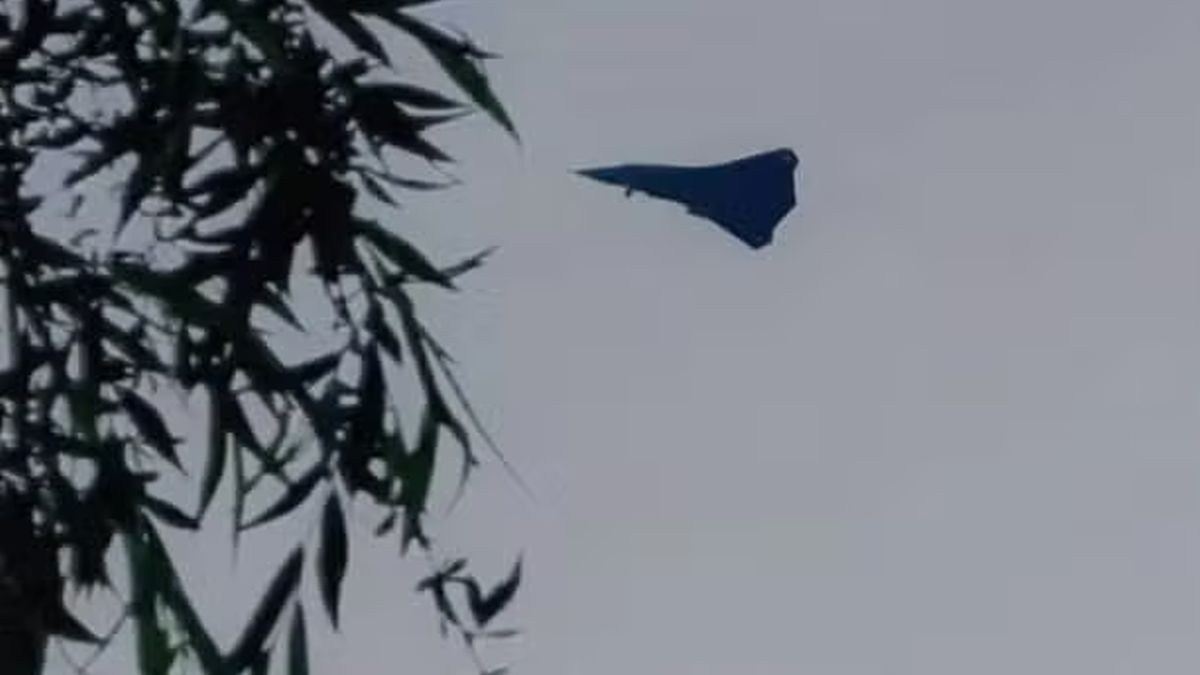Is it a jet, is it a drone — that’s the question experts are asking after images of an unidentified stealth aircraft emerged on Chinese social media.
At least two images of the aircraft began circulating earlier this week, showing a sleek, tailless design with a lambda-wing layout. Soon after the photos began circulating online, aviation experts began questioning if it was yet another sixth-generation crewed jet — similar to the J-36 — or was it one of its new advanced drones.
We try to get you the answers.
What’s that in China’s sky?
Early this week, undated images emerged on China’s social media websites, prompting chatter amongst netizens and aviation experts alike. The images taken from various angles from the ground are not clear enough to determine if the aircraft had a cockpit or internal weapons bay.
What is clear from the photos is that the new aircraft (at least from silhouettes) seems to show it has a sharply pointed nose merging into fully blended delta wings. It also appeared to have twin-engine intakes and no vertical stabilisers. This indicates that it is some kind of stealth aircraft. It also appeared that the new aircraft had a heavy-duty tricycle landing gear setup (one in the nose, two in the fuselage).
Is it a plane or is it a drone?
Soon after the images went viral, many military observers tried to ascertain the design, triggering a debate about whether it is a new piloted warplane or a “loyal wingman” drone.
Some experts pointed out that the images bore a striking resemblance to previously released images of the J-36 , China’s attempt at a sixth-generation fighter plane, which is believed to be nearly ready for pre-production testing.
According to The Aviationist, the images confirm a two-segment trailing edge, with a straight centre section that sharply angles outward before extending to the wingtips. This planform matches the geometry seen in the J-36 design.
However, others note that the images bear a resemblance to China’s designs of a ‘loyal wingman” drone. Andreas Rupprecht, a Chinese aviation expert, in a report by The War Zone noted that new imagery shows one of the country’s design of its version of the loyal wingmen programme.
For those who are unaware, “loyal wingmen” are designed to operate in coordination with piloted planes but are able to make their own tactical decisions using artificial intelligence. At a fraction of the cost of a manned fighter jet, these aircraft are seen as an easy way to scale up military might with a smaller investment. Several nations, including the US and China, are developing loyal wingman drones, with varying degrees of success.
What makes many believe that the images point to a drone is that it comes soon after satellite imagery showed several likely designs that should be publicly unveiled at an upcoming parade to be held on September 3, marking the 80th anniversary of China’s victory over Japan in World War II.
Is it yet another sixth generation aircraft?
Some analysing the images pointed out that these were proof of China building another stealth aircraft, separate from the J-36. They said that the fuselage in the images was slimmer and it was reportedly smaller too, indicating that the speed of this plane would be much faster than the J-36.
Even Rupprecht noted that the images circulated this week were significantly different from those believed to be of the J-36 that emerged last month.
Which countries have sixth-generation aircraft?
As of now, no country has a sixth-gen aircraft in deployment. However, China and the US are in a battle over sixth-generation jet fighters. Each of them is vying to be the first to field a sixth-generation craft.
Earlier, Trump announced that the US has tasked Boeing with making its sixth-generation fighter jet – which he has dubbed the F-47 . He further called it the ‘most lethal aircraft ever built’, adding that a test version of the plane had been flying in secret for years.
Meanwhile, China is reportedly also carrying out test flights of its own sixth-generation aircraft — the J-36. Developed by Chengdu Aircraft Corporation, the J-36 features a tailless design and a rare three-engine setup.
China is also developing another sixth-gen aircraft; this one by Shenyang Aircraft Corporation and possibly called the J-50. Reports state that both aircraft are expected to move at speeds beyond Mach 2, and with design tweaks, they can reach top speeds closer to Mach 3, especially at high altitudes where the air is thinner.
According to The Diplomat, based on the time China took to develop its fourth- and fifth-generation aircraft from prototype to production, it is likely that the two Chinese sixth-generation fighters might join China’s Air Force by 2031.
With inputs from agencies
)